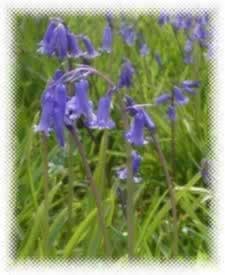Wild Hyacinth Hyacinthus nonscriptus

- Common Names
- Wild Hyacinth , Bluebell
- Botanical Name
- Hyacinthus nonscriptus
- Family
- LILIACEAE
Medicinal Uses & Benefits of Wild Hyacinth
Side Effects | Plant & Garden| Folklore
- Parts Used: Dry,powdered bulb
- Constituents: inulin, mucilage
How to Use: Wild Hyacinth
Bluebells, a classic wildflower native to Great Briton and western Europe is no longer used in herbal medicine, its slight benefits being outweighed by the toxic nature of the bulbs. According to the account by Ms. Grieve, the medicinal reputation Wild Hyacinth of England benefits greatly from being associated with the Hyacinthus of Greek mythology, although it is not clear it is in the same genus as the ancient plant of legend. What little medicinal use attributed to the plant originated in writings of John Hill, a noted 18th century botanist who recommended it as a styptic.1,2
Preparation Methods & Dosage :
Wild Hyacinth Side Effects: The fresh bulbs are poisonous, any use made of this plant is always when dried.
Plant Description
- Plant Class: Perennial
- Flowers/Fruit/Seeds:Flower stem rises from the bulb and the pendulous, bluesih-purple "bluebell" flowers drape from it in a long, curving line.
- Parts used: Bulb, starchy juice from the whole plant found uses as an early glue.
- Leaves:very long, narrow leaves
- Flowering Season:April to May
- Distribution:
Woodlands :So abundant in English woods and pastures, whilst so widely known, and popular with young and old, as to need no description. Hyacinth petals are marked in general with dark spots, resembling in their arrangement the Greek word AI, alas! because a youth, beloved by Apollo, and killed by an ill-wind, was changed into this flower. But the wild Hyacinth bears no such character on its petals, and is therefore called "non-scriptus." The graceful curl of the petals, not their dark violet colour, has suggested to the poets "hyacinthine locks."
W. T. Fernie ,M.D. Herbal Simples Approved For Modern Uses Of Cure ( 1897)
Regional Traditions :European *
History and Traditions & Folklore
Tradition associates the flower with the Hyacinth of the Ancients, the flower of grief and mourning, so Linnaeus first called it Hyacinthus. Hyacinthus was a charming and handsome Spartan youth, loved by both Apollo and Zephyrus. Hyacinthus preferred the Sun-God to the God of the West, who sought to be revenged. One day, when Apollo was playing quoits with the youth, a quoit that he threw was blown by Zephyrus out of its proper course and it struck and killed Hyacinthus. Apollo, stricken with grief, raised from his blood a purple flower on which the letters 'ai, ai,' were traced, so that the cry of woe might for evermore have existence on the earth. As our English variety of Hyacinth had no trace of these mystic letters, our older botanists called it Hyacinthus nonscriptus, or 'not written on.' A later generic name, Agraphis, is of similar meaning, being a compound of two Greek words, meaning 'not to mark.' 1
- Grieve, Maud Mrs. "A Modern Herbal" (1931)
The roots, dried and powdered, are balsamic, having some styptic properties which have not been fully investigated.
- W. T. Fernie ,M.D. (1897). "Herbal Simples Approved For Modern Uses Of Cure"
When dried and powdered, the root as a styptic is of special virtue to cure the whites of women:(Leukorrhea) in doses of not more than three grains at a time. "There is hardly," says Sir John Hill,(1796) "a more powerful remedy."











